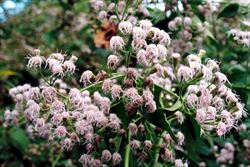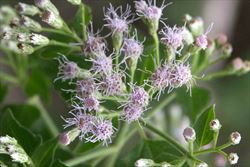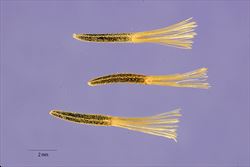Click on images to enlarge

habit (Photo: Land Protection, QDNRW)

habit in flower (Photo: Land Protection, QDNRW)

side-branches produced in pairs (Photo: Land Protection, QDNRW)

younger stem and paired leaves (Photo: Land Protection, QDNRW)

close-up of leaf (Photo: Land Protection, QDNRW)

leaves and young flower-heads (Photo: Chris Gardiner)

clusters of older flower-heads (Photo: Land Protection, QDNRW)

close-up of flower-heads (Photo: Chris Gardiner)

mature flower-heads (Photo: Land Protection, QDNRW)

close-up of seeds (Photo: Tracey Slotta at USDA PLANTS Database)

young plant (Photo: Land Protection, QDNRW)
Scientific Name
Chromolaena odorata (L.) R.M. King & H. Robinson
Synonyms
Eupatorium conyzoides VahlEupatorium odoratum L.
Family
Asteraceae (Queensland, New South Wales, the ACT, Victoria, Tasmania, Western Australia and the Northern Territory)Compositae (South Australia)
Common Names
Armstrong's weed, baby tea, bitter bush, butterfly weed, Christmas bush, chromolaena, devil weed, eupatorium, Jack in the bush, Jack-in-the-bush, kingweed, paraffinbush, paraffinweed, Siam weed, turpentine weed, triffid weed
Origin
This species is native to the warmer parts of south-eastern USA (i.e. southern Florida and Texas), Mexico, the Caribbean and tropical South America (i.e. French Guiana, Guyana, Surinam, Venezuela, Bolivia, Colombia, Ecuador, Peru, Paraguay, Brazil and northern Argentina).
Cultivation
An accidental introduction to Australia and not deliberately cultivated.
Naturalised Distribution
Siam weed (Chromolaena odorata) is a relatively recent introduction and currently has a very limited distribution in northern Queensland. However, its potential distribution is much wider than at present. It was first found in Australia in 1994, when several large infestations were spotted along the Tully River and at Bingil Bay near Mission Beach in far northern Queensland. More recent surveys have identified infestations in the Townsville-Thuringowa, Mossman and Mt Garnet areas.
It is also very widely naturalised and extremely invasive in tropical and southern Africa, tropical Asia (e.g. India, China, Indonesia, East Timor and the Philippines), the Mascarenes and the Pacific (i.e. Micronesia, Melanesia, Polynesia and Hawaii).
Habitat
A potential weed of tropical and sub-tropical regions that inhabits waterways (i.e. riparian areas), bushland, forest margins, roadsides, disturbed sites, waste areas, neglected pastures, crops and plantations.
Habit
An upright (i.e. erect) or sprawling shrub forming thickets and usually growing 1.5 to 3 m tall in the open, however it may reach greater heights (6-20 m) when climbing over trees and other taller vegetation.
Distinguishing Features
- an upright, sprawling or scrambling shrub with stems produced from a long-lived root-stock.
- its slender stems are much-branched, with the side-branches usually being produced in pairs.
- its oppositely arranged leaves (5-12 cm long and 3-7 cm wide) are triangular-shaped and have toothed margins.
- its small, fluffy, pale pink or pale mauve flower-heads are borne in dense clusters at the tips of the branches.
- its black or dark brown seeds (4-5 mm long) are topped with numerous white to brownish hairs (5-6 mm long).
Stems and Leaves
The slender stems are generally yellowish-green and somewhat hairy (i.e. pubescent), but become woody towards the base of the plant. These stems grow up to 7 m or more in length and several are usually produced from the plants long-lived root-stock (i.e. crown). They are much-branched, with the side (i.e. lateral) branches usually being produced in pairs in the leaf forks (i.e. axils).
The oppositely arranged leaves (5-12 cm long and 3-7 cm wide) are triangular or egg-shaped in outline (i.e. ovate) and have a pointed tip (i.e. acute apex). They are hairy (i.e. pubescent) on both surfaces and have coarsely toothed (i.e. serrated) margins. These leaves are borne on stalks (i.e. petioles) up to 6 cm long (usually 10-15 mm), and give off a strong odour when crushed.
Flowers and Fruit
The small flower-heads (i.e. capitula) do not have any 'petals' (i.e. ray florets) and are borne in dense clusters at the ends of the branches (i.e. in terminal panicles). These flower-heads (about 10 mm long and 3 mm wide) are pale pink or pale mauve in colour (sometimes appearing whitish when older) and consist of numerous (15-30) tiny flowers (i.e. tubular florets). These tiny flowers (10-12 mm long) are surrounded by several layers of overlapping slender bracts (i.e. an involucre) 8-9 mm long. Each flower-head (i.e. capitulum) is borne on a stalk (i.e. peduncle) 10-30 mm long. Flowering occurs from late summer through to early spring, but is most abundant during winter.
The black or dark brown 'seeds' (i.e. achenes) are 4-5 mm long and topped with a ring (i.e. pappus) of white to brownish coloured hairs (5-6 mm long).
Reproduction and Dispersal
This plant reproduces mainly by seed, which are easily blown and dispersed by the wind. Seeds may also be spread by machinery, water, vehicles, animals, in clothing, and in contaminated agricultural produce. Pieces of the crown of the plant can also take root and grow, and these may be spread about during cultivation and other soil moving activities (e.g. road maintenance).
Environmental Impact
Though Siam weed (Chromolaena odorata) is not yet widespread in Australia, and is currently being eradicated, it is regarded as a potentially very serious environmental weed in northern Australia. It is thought that this species would thrive along much of the coastal and sub-coastal districts of northern Western Australia, the Northern Territory and Queensland to north-eastern New South Wales. For this reason it is listed on both the National Environmental Weed Alert List and the Northern Australia Quarantine Strategy list. It is also seen as a major invasive species worldwide, and the Global Invasive Species Database includes it in the top 100 of the world’s worst invasive alien species.
Siam weed (Chromolaena odorata) forms dense stands that prevent the establishment of other species, both due to competition and allelopathic effects, and interferes with natural ecosystem processes in many countries. As well as altering the integrity and diversity of these natural plant communities, it can have an impact on animal populations by replacing food plants and making nesting habitats unsuitable.
Other Impacts
This species may cause skin complaints and asthma in allergy-prone people and its leaves are known to be toxic to livestock. It is also a major weed in forestry plantations and crops in tropical regions, including rubber, oil palm and coffee plantations. during the dry season, Siam weed (Chromolaena odorata) plants dry out and may become a fuel source that promotes bushfires.
Legislation
This species is declared under legislation in the following states and territories:
- New South Wales: Class 1 - a state prohibited weed. The presence of the weed on land must be notified to the local control authority and the weed must be fully and continuously suppressed and destroyed (throughout the entire state).
- Queensland: Class 1 - introduction into the state is prohibited, and landowners must take reasonable steps to keep land free of this species (throughout the entire state). It is also illegal to sell a declared plant or its seed in this state.
- Western Australia: P1 - trade, sale or movement into the state prevented, and P2 - to be eradicated (throughout the entire state).
- Northern Territory: C - not to be introduced into the Northern Territory.
Management
For information on the management of this species see the following resources:
- the Biosecurity Queensland Fact Sheet on this species, which is available online at http://www.dpi.qld.gov.au.
- the Northern Territory Department of Natural Resources, Environment and The Arts Agnote on this species, which is available online at http://www.nt.gov.au/weeds.
- the New South Wales Department of Primary Industries Weed Alert on this species, which is available online at http://www.dpi.nsw.gov.au.
Similar Species
Siam weed (Chromolaena odorata) may occasionally be confused with Senegal tea plant (Gymnocoronis spilanthoides), crofton weed (Ageratina adenophora) and mistflower (Ageratina riparia). These species can be distinguished by the following differences:
- Siam weed (Chromolaena odorata) is a large upright, terrestrial plant (1.5-5 m tall) with stems that are not hollow and relatively broad leaves with slightly toothed (i.e. serrated) margins. Its small flower-heads (about 3 mm across) are pale pink or mauve in colour and are borne in dense clusters at the tips of the branches.
- Senegal tea plant (Gymnocoronis spilanthoides) is a semi-aquatic plant (1-1.5 m tall) with somewhat hollow stems and relatively narrow leaves with finely toothed (i.e. serrated) margins. Its relatively large flower-heads (15-20 mm across) are white or pale purplish in colour and borne in few-flowered clusters at the tips of the branches.
- crofton weed (Ageratina adenophora) is an upright, terrestrial plant (1-2 m tall) with stems that are not hollow and relatively broad leaves with slightly toothed (i.e. crenated or serrated) margins. Its small flower-heads (5-7 mm across) are white in colour and borne in dense clusters at the tips of the branches.
- mistflower (Ageratina riparia) is a low-growing (i.e. decumbent) or scrambling terrestrial plant (40-60 cm tall) with stems that are not hollow and relatively narrow leaves with toothed (i.e. serrated) margins. Its small flower-heads (about 5 mm across) are white in colour and borne in dense clusters at the tips of the branches.
Billygoat weed (Ageratum conyzoides subsp. conyzoides), blue billygoat weed (Ageratum houstonianum), praxelis (Praxelis clematidea) and vernonia (Cyanthillium cinereum) have similar flowers to Siam weed (Chromolaena odorata), but they are usually much darker pink or bluish in colour. These species are also much smaller annual plants (usually less than 1 m tall).
Another species of chromolaena (i.e. Chromolaena squalida) has also become locally naturalised in northern Queensland. It has similar leaves and flowers to Siam weed (Chromolaena odorata), but it is usually not very branched and much smaller in stature (less than 1.5 m tall).

